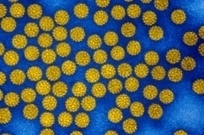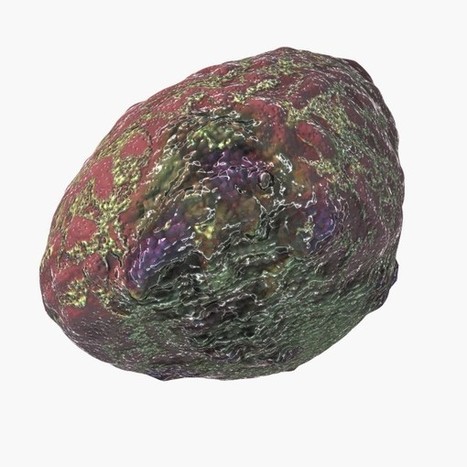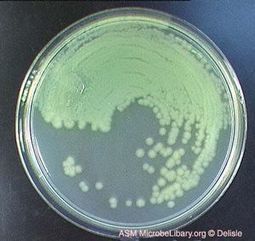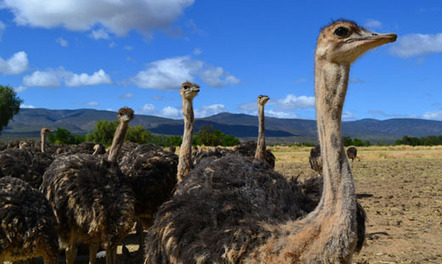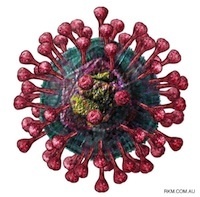 Your new post is loading...
 Your new post is loading...

|
Scooped by
Ed Rybicki
May 20, 2012 8:51 AM
|
"For many diseases, our immunological memories can endure like etchings in stone. Once children get shots for polio, they're usually protected for the rest of their lives. Unfortunately, the same can’t be said for the flu virus. When it comes to influenza, it’s as if we have short-term amnesia. Every fall, doctors offices and pharmacies get a fresh load of influenza vaccines. Time and again, studies have demonstrated that flu vaccines are effective—but usually only for a single flu season. When the next flu season arrives, the viruses have changed, and we have little protection from the year before. We have to teach our immune systems yet another lesson." Nice essay, from a master of the art of making science palatable to civilians. He very ably explores the concept of universal vaccines for flu - something I for one would welcome!

|
Scooped by
Ed Rybicki
May 18, 2012 6:11 AM
|
"If the world acts with strategy and speed to implement the proven and emerging options, the epidemic should be on a measurable downward trajectory over the next five to ten years. Why, then, do we still need an AIDS vaccine? Because we want to end the epidemic. If the potential of combination prevention is realized over the next ten years, there will be vast reductions in the numbers of new HIV infections and AIDS deaths. If combination prevention targets do not get met in the next ten years, this will be a global tragedy. In either scenario, an AIDS vaccine is an essential tool." Great article - and on HIV Vaccine Awareness Day, too!

|
Scooped by
Ed Rybicki
May 18, 2012 5:59 AM
|
There is a growing consensus that we can significantly curtail the HIV/AIDS pandemic by implementing scientifically proven HIV prevention strategies, such as voluntary medically supervised adult male circumcision, prevention of mother-to-child transmission and treatment as prevention. With 2.7 million new HIV infections in 2010 alone, however, it is likely that controlling and ultimately ending the HIV/AIDS pandemic will require an effective vaccine as well. This past year, there have been a number of encouraging findings on this front. Last month, a detailed analysis of specimens from the first HIV vaccine clinical trial to show a modest protective effect yielded important clues about how the vaccine might have worked. These clues suggest directions for improving upon the original vaccine regimen to confer a broader, more potent and longer-lasting effect. The original vaccine regimen was tested among 16,000 adult volunteers in Thailand in a trial co-funded by the National Institute of Allergy and Infectious Diseases (NIAID), part of NIH. Meanwhile, several other NIAID-sponsored HIV vaccine clinical trials are under way. The largest of these is examining whether a prime-boost vaccine regimen can prevent HIV infection or reduce the amount of virus in the blood of those participants who become infected despite vaccination. These trials are possible because of the generous contributions of time and effort by thousands of study participants, community educators, health care workers and scientists. All those involved deserve our gratitude.

|
Scooped by
Ed Rybicki
May 18, 2012 5:54 AM
|
Led Zeppelin / Finger Flu 1975 Chicago Tapes Volume 2 / 2CD /TCOLZ Click Image To Enlarge Related posts:Led Zeppelin / Demand Unprecedented In The History Of Rock Music / 1DVDLed Zeppelin / One Nation Dancing ... Flu of a different kind!! I DID promise you other things....

|
Scooped by
Ed Rybicki
May 15, 2012 10:23 AM
|
Ghana's children given hope by rollout of new rotavirus vaccine. Gavi and Ghana's government are rolling out vaccines against diarrhoea and pneumonia, a major threat to children under five. In Accra's Independence Square, a baby cries as ...

|
Scooped by
Ed Rybicki
May 15, 2012 10:17 AM
|
Taking Truvada daily can help people in at-risk groups prevent H.I.V. infection, but the consequences of loose adherence go beyond contracting the virus. A panel of advisers to the Food and Drug Administration took a historic step last week when they recommended that the agency for the first time approve a drug that healthy people can take once a day to prevent H.I.V. infection.
Such a pill has long been a goal of research, something that might help stem a global epidemic that is still causing two million new worldwide cases each year, including 50,000 in the United States. But the panel members worried about how to make sure doctors and patients would use the drug correctly. Otherwise, they said, the potential harm could be huge — not just to those taking the pill, but also to their sexual partners. While this is a very important step towards preventing HIV infection, it is equally important to remember that it IS only a step - and not the final solution. Condoms remain the better option, in that a barrier is better than a drug; however, the chemical option may help curb the spread of the virus where other measures have not. Until we get vaccines!!

|
Scooped by
Ed Rybicki
May 15, 2012 10:12 AM
|
Via the Hong Kong government website: Influenza caution issued. The Centre for Health Protection today warned the public to be vigilant against influenza, as flu activity remains high. The weekly number of flu virus detections ...

|
Scooped by
Ed Rybicki
May 13, 2012 8:40 AM
|
"A debate rages among scientists about the value vs. the risk of a study on the genetic engineering of a much deadlier avian flu virus. A science journal is poised to publish a study that some experts believe could give a recipe to bioterrorists.
The study is from an experiment by a Dutch scientist who engineered the avian flu virus to make it more deadly to mammals by making it spread through the air.
That experiment was funded by the U.S. government, and it has sparked a passionate debate among scientists. Part of that debate is over where this research could lead, and whether it is worth it." And the hype machine cranks ON...! Seriously, unless we KNOW how the damn virus CAN change in order to become mre transmissible, we won't know if it HAS - until it bites us. I find it amazing, personally, that a couple of nay-sayers can get as much publicity as they have - because they were outvoted 2 to 1.

|
Scooped by
Ed Rybicki
May 12, 2012 6:55 AM
|
"We present the first attempt at quantitative analysis of morphological diversity of tailed viruses obtained from marine sediments without ultracentrifugation or enrichment on specific host strains. Sandy mud samples were collected in the Gulf of Gdańsk in the spring, autumn and winter. VLPs were analyzed by transmission electron microscopy. The distribution of three groups of tailed phages was similar in all seasons (Siphoviridae: 52% on average; Myoviridae: 42%; Podoviridae: 6%). 19% of siphoviruses had prolate heads. Interestingly, 11% of siphoviral particles had tails longer than 300 nm, and 6% longer than 600 nm." Cool Polish names - and even cooler phages. I am growing to love phages.... Thanks to @MicrobeTweets!

|
Scooped by
Ed Rybicki
May 11, 2012 1:51 PM
|
One in six cancer cases worldwide can be traced back to preventable or treatable infections, finds a new study. The data show that 2 million new cancers in 2008 were caused by such infections.

|
Scooped by
Ed Rybicki
May 11, 2012 7:36 AM
|
The shingles vaccine is “generally safe and well tolerated,” according to a study of nearly 200,000 patients. Shingles, or herpes zoster, is a painful rash caused by reactivation of chickenpox virus that has remained dormant in the body. Up to 1 million Americans, more than half of whom are 60 or older, are diagnosed with shingles every year, the researchers write. Researchers analyzed data of 193,083 vaccinated patients aged 50 or older for certain side effects that could be related to the shingles vaccine. The researchers found no increased risk in the first six weeks after vaccination for stroke, heart disease, infections of the brain or spinal cord or other brain diseases, Bell's palsy, or Ramsay-Hunt syndrome, which can occur when the virus that causes shingles affects the facial nerve near an ear. An increased risk of allergic reaction was found in the first week after receiving the shingles vaccine. A majority of these reactions involved an inflammatory response at the injection site, involving symptoms such as redness, swelling, and mild pain.

|
Scooped by
Ed Rybicki
May 11, 2012 7:25 AM
|
The first drug shown to prevent HIV infection won the endorsement of a panel of federal advisers Thursday, clearing the way for a landmark approval in the 30-year fight against the virus that causes AIDS. In a series of votes, a Food and Drug Administration advisory panel recommended approval of the daily pill Truvada for healthy people who are at high risk of contracting HIV, including gay and bisexual men and heterosexual couples with one HIV-positive partner. The FDA is not required to follow the panel’s advice, though it usually does. A final decision is expected by June 15. Read more: FDA advisers back first drug to prevent HIV - AIDS/HIV -Drug News - http://www.health.am/ab/more/fda-advisers-back-first-drug-to-prevent-hiv/#ixzz1uYkFqEmo

|
Scooped by
Ed Rybicki
May 8, 2012 7:43 AM
|
A dairy cow from California tested positive for Mad Cow disease, or Bovine spongiform encephalopathy, setting off an investigation by the FDA.
|

|
Scooped by
Ed Rybicki
May 20, 2012 8:46 AM
|
Granulosis Virus 3D Model available on Turbo Squid, the world's leading provider of digital 3D models for visualization, films, television, and games While I don't normally endorse an alternative supplier of graphics, this is VERY nice. Pity there's no information about WHICH granulosis virus....

|
Scooped by
Ed Rybicki
May 18, 2012 6:01 AM
|
Subunit vaccines are significantly more expensive to produce than traditional vaccines because they are based primarily on recombinant proteins that must be purified from the expression system. Despite the increased cost, subunit vaccines are being developed because they are safe, effective, and can elicit antibodies that confer protection against diseases that are not currently vaccine-preventable. Algae are an attractive platform for producing subunit vaccines because they are relatively inexpensive to grow, genetically tractable, easily scaled to large volumes, have a short generation time, and are devoid of inflammatory, viral, or prion contaminants often present in other systems. We tested whether algal chloroplasts can produce malaria transmission blocking vaccine candidates, Plasmodium falciparum surface protein 25 (Pfs25) and 28 (Pfs28). Antibodies that recognize Pfs25 and Pfs28 disrupt the sexual development of parasites within the mosquito midgut, thus preventing transmission of malaria from one human host to the next. These proteins have been difficult to produce in traditional recombinant systems because they contain tandem repeats of structurally complex epidermal growth factor-like domains, which cannot be produced in bacterial systems, and because they are not glycosylated, so they must be modified for production in eukaryotic systems. Production in algal chloroplasts avoids these issues because chloroplasts can fold complex eukaryotic proteins and do not glycosylate proteins. Here we demonstrate that algae are the first recombinant system to successfully produce an unmodified and aglycosylated version of Pfs25 or Pfs28. These antigens are structurally similar to the native proteins and antibodies raised to these recombinant proteins recognize Pfs25 and Pfs28 from P. falciparum. Furthermore, antibodies to algae-produced Pfs25 bind the surface of in-vitro cultured P. falciparum sexual stage parasites and exhibit transmission blocking activity. Thus, algae are promising organisms for producing cysteine-disulfide-containing malaria transmission blocking vaccine candidate proteins. What can I say...go green!

|
Scooped by
Ed Rybicki
May 18, 2012 5:54 AM
|
While I'm not sure every reader will find The Great Influenza equally compelling, I must say that this one was quite the read for me! It was fascinating, challenging, and complex–complex in a good way.

|
Scooped by
Ed Rybicki
May 15, 2012 12:35 PM
|
by S. Marvin Friedman "The emergence of multiple drug-resistant bacterial strains, the prevalence of recalcitrant biofilm configurations, and the reluctance of the pharmaceutical industry to initiate new antibiotic discovery programs have led to the development of a formidable population of bacterial pathogens that is increasingly difficult to control. After a long but successful era of research that had all but eliminated serious threats from bacterial infections, we are now facing this dire problem once again. In response, researchers have recently been exploring alternative approaches to antibiotic therapy including identifying chemical agents that antagonize quorum sensing and thus prevent population-wide expression of virulence genes, as well as employing either intact bacteriophages or their isolated lysins to directly kill their pathogenic bacterial hosts. Lysins kill Gram-positive bacteria by hydrolyzing the peptidoglycan in the cell wall, thereby causing cell lysis. Gram-negative bacteria are immune to their action because their outer membrane does not allow the lysins access to their peptidoglycan. I will now summarize two recent papers that use intact phages to combat two important bacterial pathogens, both in vitro and in vivo." As a new-minted phage enthusiast, and a fan of Small Things Considered, I am more than happy to reblog this. I think phages may well be the answer to multiply- or extreme-resistant bugs, and in the long term will probably prove to be a better answer than antibiotics in general. After all, they can evolve - and penicillin can't. Moreover, we can select them out of the environment and then select them rigorously in the lab, to pretty much get anything we want. You gotta love viruses...B-)

|
Scooped by
Ed Rybicki
May 15, 2012 10:18 AM
|
Apple is no longer the safe choice for computer shoppers as various malicious software downloads have become available over the last several months. I watch and wait nervously....

|
Scooped by
Ed Rybicki
May 15, 2012 10:12 AM
|
AFPPeople With HIV at Higher Odds of Sudden Cardiac DeathU.S.

|
Scooped by
Ed Rybicki
May 13, 2012 8:43 AM
|
KADOMA- Women should always have bald heads, lose weight and dress shabbily to reduce their attractiveness as part of measures to curb the spread of HIV, MDC-T Senator for Chikomo, Morgan Femai said yesterday. Shave YOUR head, Senator...oh, wait: you already did. Just shows, being an idiot is a state of being not restricted to ZANU-PF members.

|
Scooped by
Ed Rybicki
May 13, 2012 8:05 AM
|
Editor’s Note: The draft of the Global Vaccine Action Plan (GVAP) developed by the Decade of Vaccines Collaboration was posted as part of the 65th World Health Assembly meeting documentation http... ACTION BY THE HEALTH ASSEMBLY 107. The Health Assembly is invited to adopt the resolution on World Immunization Week recommended by the Executive Board in resolution EB130.R12. 108. It is further invited to consider the following draft resolution:
The Sixty-fifth World Health Assembly,
- Having considered the report on the draft global vaccine action plan;1
- Recognizing the importance of immunization as one of the most cost-effective interventions in public health which should be recognized as a core component of the human right to health;
- Acknowledging the remarkable progress made in immunization in several countries to ensure that every eligible individual is immunized with all appropriate vaccines, irrespective of geographic location, age, gender, disability, educational level, socioeconomic level, ethnic group or work condition;
- Applauding the contribution of successful immunization programmes in achieving global health goals, in particular in reducing childhood mortality and morbidity, and their potential for reducing mortality and morbidity across the life-course;
- Noting that the introduction of new vaccines targeted against several important causes of major killer diseases such as pneumonia, diarrhoea and cervical cancer can be used as a catalyst to scale up complementary interventions and create synergies between primary health care programmes; and that beyond the mortality gains, these new vaccines will prevent morbidity with resulting economic returns even in countries that have already succeeded in reducing mortality;
- Concerned that, despite the progress already made, disease eradication and elimination goals such as the eradication of poliomyelitis, the elimination of measles, rubella, and maternal and neonatal tetanus cannot be met without achieving and sustaining high and equitable coverage;
- Concerned that low- and middle-income countries where the adoption of available vaccines has been slower may not have the opportunity to access newer and improved vaccines expected to become available during this decade;
- Alarmed that globally routine immunization services are not reaching one child in five, and that substantial gaps persist in routine immunization coverage within countries; Recalling resolutions WHA58.15 and WHA61.15 on the global immunization strategy,
1. ENDORSES the Global Vaccine Action Plan;
2. URGES Members States:
(1) to apply the vision and the strategies of the Global Vaccine Action Plan to develop the vaccines and immunization components of their national health strategy and plans, according to the epidemiological situation in their respective countries;
(2) to commit themselves to allocating adequate human and financial resources to achieve the immunization goals and other relevant key milestones;
(3) to report every year to the regional committees during a dedicated Decade of Vaccines session, on lessons learnt, progress made, remaining challenges and updated
actions to reach the national immunization targets

|
Scooped by
Ed Rybicki
May 11, 2012 1:53 PM
|
The World Health Organization’s (WHO) is set to support an ambitious new blueprint for getting vaccines to those who need them most. Experts from across the world will gather later this month for the World Health Assembly – the WHO’s key decision-making body – to debate the Global Vaccine Action Plan which has been drawn up by the Decade of Vaccines Collaboration.
The latest draft of the Action Plan has been published as part of an exhaustive consultation exercise which saw 1,100 contributions submitted from more than 140 countries. Academics, policymakers, as well as representatives from the private sector and non-governmental organisations fed into the process which began last year.
The plan has three primary aims:
Provide life-saving vaccines to those who need them most
Maintain a strong pipeline of new vaccines
Strengthen public support for vaccination efforts

|
Scooped by
Ed Rybicki
May 11, 2012 7:37 AM
|
Grassroots Goal: HIV Prevention on the Soccer FieldKnowledge Wharton HighschoolJeff DeCelles is the director of curriculum, partnerships and innovation for Grassroot Soccer, an organization in Cape Town, South Africa that uses soccer to teach young...

|
Scooped by
Ed Rybicki
May 11, 2012 7:28 AM
|
"CAPE TOWN - The Western Cape Agriculture Department on Monday said it planned to complete the culling of ostriches affected by bird flu in the Karoo by the end of this week. Agriculture MEC Gerrit van Reinsburg met with industry players in Oudtshoorn earlier. More than 40,000 ostriches have been culled since the initial outbreak of avian influenza in March 2011. The European Union also imposed a ban on South African ostrich exports at a cost of hundreds of millions of rand to affected farmers. The EU imported 90 percent of South Africa’s ostrich meat. The department's Wouter Kriel said, “The Department of Agriculture will conclude the culling operation that has been ongoing for the past year in the ostrich industry. The last 360 ostriches will be culled this week.” The department said it would monitor the area carefully in the following weeks. The department will in the next three months apply to the EU for the resumption of ostrich exports. According to the department, the entire Klein Karoo Valley, home to about 70 percent of the country's ostrich industry, was affected by the outbreak. The affected farmers received R50 million in compensation from the national government." And you know why they have to cull them, when there ARE vaccines available? Because the EU does not like ostriches with antibodies to influenza viruses. Because they steadfastly refuse to step into the 21st century, and allow use of tests which disciminate vaccinated and infected birds.

|
Scooped by
Ed Rybicki
May 8, 2012 8:42 AM
|
"To better understand the genetic diversity and genomic features of 41 coronaviruses (CoVs) identified from Kenya bats in 2006, seven CoVs as representatives of seven different phylogenetic groups identified from partial polymerase gene sequences, were subjected to extensive genomic sequencing. As a result, 15–16 kb nucleotide sequences encoding complete RNA dependent RNA polymerase, spike, envelope, membrane, and nucleocapsid proteins plus other open reading frames (ORFs) were generated. Sequences analysis confirmed that the CoVs from Kenya bats are divergent members of Alphacoronavirus and Betacoronavirus genera. Furthermore, the CoVs BtKY22, BtKY41, and BtKY43 in Alphacoronavirus genus and BtKY24 in Betacoronavirus genus are likely representatives of 4 novel CoV species. BtKY27 and BtKY33 are members of the established bat CoV species in Alphacoronavirus genus and BtKY06 is a member of the established bat CoV species in Betacoronavirus genus. The genome organization of these seven CoVs is similar to other known CoVs from the same groups except for differences in the number of putative ORFs following the N gene. The present results confirm a significant diversity of CoVs circulating in Kenya bats. These Kenya bat CoVs are phylogenetically distant from any previously described human and animal CoVs. However, because of the examples of host switching among CoVs after relatively minor sequence changes in S1 domain of spike protein, a further surveillance in animal reservoirs and understanding the interface between host susceptibility is critical for predicting and preventing the potential threat of bat CoVs to public health." We need to start worrying about MORE viruses from bats?? I knew those caves were a bad idea.... Graphic from Russell Kightley Media
|



 Your new post is loading...
Your new post is loading...











